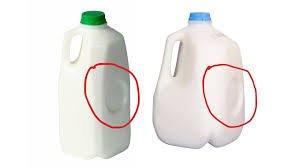Why Milk Jugs Have a Circular Dent: The Hidden Engineering Explained
Those small circular dents (or dimples) near the top of milk jugs aren’t just random—they’re a clever design feature with multiple practical purposes. Here’s why they exist:
1. Structural Stability
-
Prevents Bulging: Milk jugs are blow-molded from lightweight plastic (usually HDPE). The dent acts as a “crumple zone” to absorb pressure changes.
-
Without it, temperature shifts (e.g., refrigeration to room temp) could cause the jug to warp or bulge awkwardly.
-
-
Even Expansion/Contraction: The dimple gives the plastic room to flex slightly without distorting the jug’s shape.
2. Grip and Handling
-
Ergonomic Design: The dent provides a natural thumb grip for pouring, reducing spills.
-
Stacking Stability: It helps nested jugs align neatly in fridges or store shelves.
3. Manufacturing Efficiency
-
Material Savings: The indentation reduces plastic use slightly without compromising strength, cutting costs and environmental impact.
-
Mold Release: Helps the jug detach cleanly from manufacturing molds.
4. Historical Evolution
-
Older glass milk bottles had no dents, but plastic’s flexibility required smart engineering to avoid deformation. The circular dent became a standard solution in the 1970s with the rise of plastic jugs.
Bonus: Why Some Jugs Have Square Dents
-
Gallon jugs often have a square-ish panel near the base—another stability feature to prevent buckling when lifted (since milk is heavy!).
TL;DR: That tiny dimple is a masterclass in functional design—balancing strength, usability, and cost-effectiveness. Next time you pour milk, thank the engineers! 🥛😄
Fun fact: Similar dents appear on laundry detergent bottles and oil containers for the same reasons!
